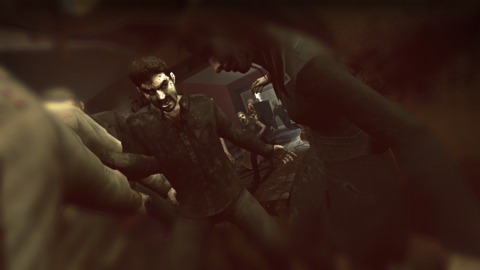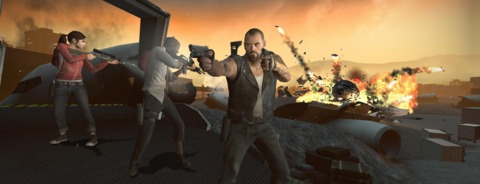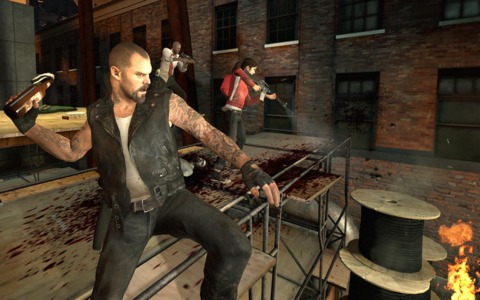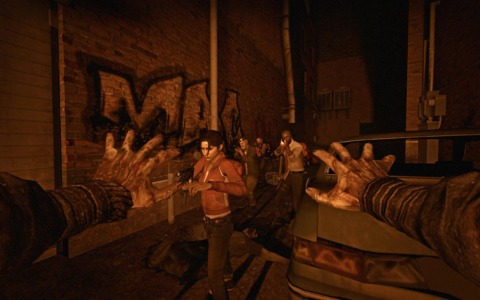
The beauty of Left 4 Dead is that it taps into a vision of the zombie apocalypse that is so familiar from films that it allows for a frightening economy in the way the game establishes its characters and setting. The game opens up “two weeks after first infection” with a brief cinematic of the four survivors amidst a horde of attacking zombies, and it's the closest the game comes to providing out-and-out exposition. The lack of further explanation of how the zombie pandemic started actually works to the game's advantage, as confusion and the fear of the unknown are two of the greatest strengths of a good zombie scenario. On a practical level, you'll be so concerned with simply surviving that any other concerns quickly fall by the wayside.
There are some blurbs in the game's manual that provide a little more back story for the four survivors, but they're all so archetypal in appearance and behavior--though without feeling generic--that you get a great sense of who these people are simply by interacting with them. The game also uses the state of the world itself to drive home just how bad things have gotten. Alternating between city streets, open wilderness, and other hallmarks of modern civilization such as hospitals and airports, this is a world that you know, albeit one scattered with the debris of previous carnage where civil services have broken down all but completely, and anyone still alive has boarded themselves up inside buildings and armed themselves to the teeth.

The campaign mode consists of four independent scenarios, the objectives for which are consistent throughout: survival. You'll start out stranded in one location, surrounded by the undead, and you'll fight from one safe house to the next, working your way towards a destination where you'll presumably find rescue. Between points A and B, you'll find yourself in a world undulating with mobs of shuffling, “common” zombies who, if left to their own devices, will usually just ignore you. If you shoot a zombie, or disturb them by operating machinery or accidentally set off a car alarm, they'll snap to attention and start sprinting towards you with the singular focus of tearing you to shreds. In small groups, these brown-label zombies don't pose much of a threat, though the game will regularly try to overwhelm you with hordes of them, which is a simply terrifying sight.
Of greater concern are the breeds of special zombies, who are tougher than the regular horde, and who come with some unique and deadly abilities. Boomers are corpulent, dyspeptic blobs who can hit survivors with a blast of vomit that both blinds them and causes them to attract a horde of zombies. The smoker tends to hang out further away from the main path, using its long tongue to drag survivors towards it. The hunter is a quick and nimble zombie who, when close enough, will pounce on a survivor and maul them. The tank is a hulking, thick-skinned beast that will tear up hunks of concrete and hurl them from afar, and it only takes one or two punches from one of these to incapacitate a survivor. Each of these special zombies require the use of specific tactics, though none are as dangerous or unique as the witch, who appears to be a thin wisp of a girl who, if left undisturbed, will simply sit on the ground and whimper plaintively. But if you get too close, shine your flashlight on her, or, God forbid, shoot her, she turns into a screaming whirlwind of deadly claws that can be quite difficult to put down. The game constantly encourages you to avoid the witch at all costs, and with good reason.

There's also a versus mode which pits two teams of four against each other--one as the survivors, and one as the zombies--with the roles alternating between rounds. Save for the increased difficulty of playing against live opponents, playing as the survivors isn't much different from the campaign mode, though playing as the zombies is an entirely different experience. Zombies aren't anywhere near as resilient as the survivors, but while the survivors have only one life per round, zombies can spawn repeatedly. With each life, you're randomly assigned to a different type of special zombie--either boomer, smoker, hunter, or tank--before you're allowed to choose your spawn point, preferably near the survivors, though the game puts a limit on how close you can spawn. Stalking your prey and coordinating with your zombie teammates makes this the antithesis of the survivor experience, and the presence of plenty of common zombies keeps the versus mode feeling true to the campaign. It's a shame that, for some inexplicable reason, only two of the four maps that Left 4 Dead ships with can be played in the versus mode, simply because it's so much fun.

As with The Orange Box, Left 4 Dead features a developer commentary mode which places brief bits of audio commentary throughout the game. The delivery can be a little dry at times, and it might be a little too nuts-and-bolts for some, though the insight provided into the process behind the game, as well as how the choices made have an impact on the final product, are consistently fascinating.
Left 4 Dead runs on the Source engine, the same engine that powered Half-Life 2 some four years ago. It's definitely getting a little long in the tooth, but it still puts on a pretty good show here. The game's smart use of lighting, film-grain effects, and various, subtle contrast and color effects give much of the world a desolate, washed-out feeling. The character models feature some of the most realistic, emotive faces I've seen in a game, and the stride of their animations will change depending on their current condition, to the point that you don't even have to look a a survivor's health bar to know how they're doing. There are some quirks, with interactions between characters being pretty consistently awkward, but the game's art direction is so thoroughly engrossing that the problems are easy to ignore.

The PC and Xbox 360 versions are pretty comparable across the board, though there are a few predictable deviations, such as the higher resolutions afforded by the PC hardware and the sharper controls of a mouse and keyboard. Communication with your team is key in Left 4 Dead, and while the PC version supports voice chat, it's not as standardized as it is on the 360, and you can't expect every player to have a headset. While the PC version features a quick dialogue tree that lets you call out a few specific phrases, it's no substitute for direct communication.
Due to the mere four scenarios included in Left 4 Dead, the biggest factor in deciding between the two versions will be post-release support. The standalone nature of the scenarios would make it easy for Valve and/or the community to cook up some new and exciting levels, which could extend the life of the game considerably. The Xbox 360 version is still terrific fun, though the limited post-release support that Valve has provided for the contents of The Orange Box on the 360, compounded by the inability of players to distribute their own custom maps, potentially gives the PC version a distinct advantage.
Beyond its categorical success in establishing a vivid picture of the zombie apocalypse, Left 4 Dead's biggest breakthrough is the way it blurs the lines between the often compartmentalized pieces of a modern first-person shooter. It makes for a game that's unlike any other, and while the limited amount of content is admittedly unfortunate, that shouldn't keep you from experiencing this fast-paced, nerve-wracking game.